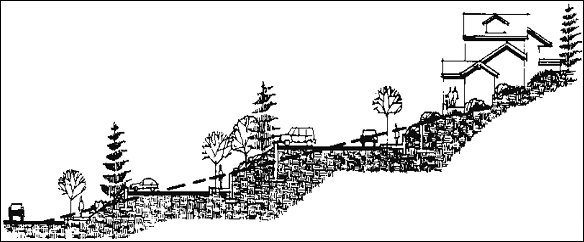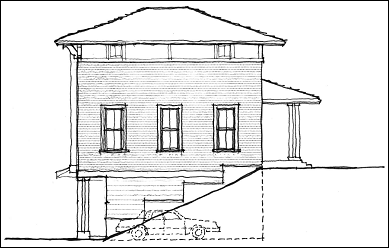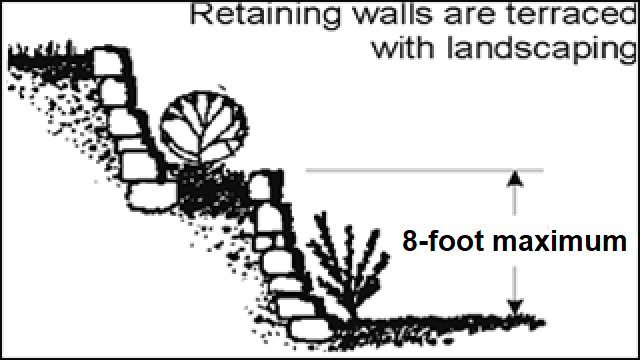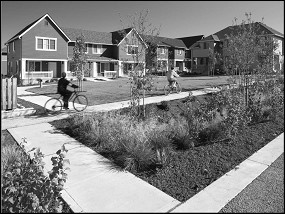22.42.040 Land disturbing activity.
A. Purpose. The purpose of this section is to minimize soil disturbance, integrate new developments into the natural terrain, contain and manage storm water runoff on site, and minimize impermeable site area.
B. Applicability. This section applies to all land disturbing activity, as defined in Chapter 22.12 MMC, Definitions.
C. Standards for Land Disturbing Activity. Minimal grading is essential to developing sites that are integrated into the natural environment. Developments shall work with the site topography in determining the final grade for the site.
1. Whenever possible, roads should follow existing contours and grading should be minimized by the design of the structures.
2. Filling and grading plans shall be prepared based on topographic data and comply with the city’s critical areas ordinance, Chapter 22.80 MMC.
3. Filling and grading shall control storm water runoff impacts to adjacent properties, and shall preserve existing significant trees wherever possible.
4. Mass grading and land clearing for the purpose of establishing flat building lots is not permitted. The following techniques shall be used instead:
a. Sites shall be designed to blend into the existing topographic contours and shall minimize cuts and fills;
b. A series of benches and landscaped terraces (see Figure 22.42.040(C)(4): Terracing) shall be used on large grade changes to create a gradual slope. Terracing shall be subject to the following requirements:
i. Terraces at least five feet in width shall be established at not more than thirty-foot vertical interval with a planted stable slope not exceeding a grade steeper than one unit vertical to three units horizontal (thirty-three percent slope);
ii. Where only one terrace is required, it shall be at mid-height of the slope.
iii. The exposed portion of retaining walls shall be limited to no more than two eight-foot terraced walls within one hundred horizontal feet of one another. In addition to the administrative departure criteria in MMC 22.42.100, a departure may be granted for this subsection if the developer can show that they meet the departure requirements and demonstrate that grading is minimized through the use of tuck-under garages and daylight basements.
iv. Terrace widths and spacing for cut and fill slopes greater than one hundred twenty feet in height shall be designed by a civil engineer.
v. When applicable, suitable access, as determined by the public works director or designee, shall be provided to permit proper cleaning and maintenance of drainage facilities.
5. On steeper sites, tuck-under garages and daylight basements are encouraged and may be required to integrate homes into existing topography and minimize mass grading (see Figure 22.42.040(C)(5): Tuck-Under Garage); or
6. Other alternative methods that meet the purpose of this chapter may be approved by the zoning administrator.
Figure 22.42.040(C)(4). Terracing

Figure 22.42.040(C)(5). Tuck-Under Garage

D. Required Grading Setbacks.
1. Cuts and fills shall be set back a minimum of two feet from the property line unless both of the following are provided:
a. A construction easement, written agreement or letter of authorization from all of the affected property owners allowing a setback of less than two feet; and
b. A survey by a land surveyor licensed in Washington State that ensures compliance with construction and land disturbing activity site plans prior to construction of cut, fill, rockery, or a retaining wall proposed within six inches of a property line.
2. In no case may the top or toe of a slope, including terraced slopes as described in subsection (C)(4)(b) of this section, with a cumulative vertical height in excess of six feet be placed within a required yard setback area for any single or multifamily dwelling or within ten feet of the nearest residential building facade, whichever is greater.
3. Before performing any land disturbing activity, the applicant shall mark on the site and show on the land disturbing activity site plan the limits of all proposed land disturbing activities, trees and native vegetation to be retained, and drainage courses, so that setbacks can be determined. Cut and fill slopes shall be set back from site boundaries in accordance with this section. Setback dimensions shall be horizontal distances measured perpendicular to the site boundary.
E. Retaining Walls. The following standards apply to all retaining walls greater than four feet in height:
1. Retaining walls shall be set back a minimum of five feet from adjacent public rights-of-way, vehicular access easements, utility easements, and other retaining walls.
2. Retaining walls shall maintain a minimum five-foot separation between walls or will be considered one wall, as it applies to this chapter.
3. The area between a public right-of-way and a retaining wall shall be landscaped and maintained per Chapter 22.46 MMC, Landscaping Standards. If private agreements are reached with utility companies, and written documentation is provided to the city, retaining walls may be located to the back of the right-of-way if approved through an administrative departure.
4. Retaining walls visible from a public right-of-way or adjacent property shall be rock, keystone-style, or cast in place concrete with textured/patterned wall styles, as approved by the city.
5. Large block walls (ecology block style) are not permitted where the retaining wall is visible from a public right-of-way.
6. Retaining walls shall be designed to fit their surroundings and complement existing conditions.
7. For residential lots, retaining walls:
a. Shall be composed of brick, rockery, CMU, or landscape block or a combination of masonry products. Concrete may be used for retaining walls with a height less than four feet.
b. Shall be located a minimum of ten feet from the rear of any residential building.
c. May abut, but shall not be located on, property lines.
Figure 22.42.040(E). Retaining Wall Height and Separation

F. Storm Water Management.
1. Storm Water Ponds. Open storm water facilities, such as ponds, shall be screened through layout, design, and landscape treatment.
a. Storm water ponds shall be designed, constructed, and maintained per the storm water management manual, as designated by Chapter 15.01 MMC, Storm Water Management, and the City of Monroe Public Works Design and Construction Manual.
b. When a fence is needed (where slopes are greater than three to one) around the perimeter of a storm water pond, solid board or chain link fence with slats are prohibited. A dark green, brown or black vinyl coated chain link fence or similar fence is acceptable. These fence types will allow vegetation to grow through and shall be used in conjunction with landscape requirements in Chapter 22.46 MMC, Landscaping Standards. Rectangular fence layouts are discouraged.
2. Low Impact Development. Bioswales, bio-retention, and other low impact development techniques shall be used in accordance with the Puget Sound Partnership Low Impact Development Technical Guidance Manual for Puget Sound (December 2012), throughout developments to treat runoff, improve water quality, and minimize or eliminate the size of detention ponds or vaults. If used, low impact techniques shall be integrated into the overall site and landscape design, meet the city’s design criteria for water quality treatment, and shall either be grass lined or landscaped with appropriate species.
Figure 22.42.040(F). Bioswale with Native Vegetation

G. Impervious Surface Coverage. The layout of new developments shall minimize impervious surface area in order to maximize storm water infiltration and reduce the amount of storm water that is transferred off site.
1. The maximum percentage of total impervious surface for developments shall be consistent with the requirements of the individual zoning districts.
2. On-site native vegetation shall be preserved to the greatest extent possible to protect the aesthetic qualities of the region, to protect aquifers, provide wildlife habitat, and prevent runoff detrimental to adjoining properties, streams, and other sensitive areas.
3. The use of pervious surfaces is encouraged. Porous concrete, porous paving stones, reinforced turf, crushed gravel with soil stabilizers, and paving blocks with planted joints are examples of acceptable materials that can be used for driveways, pathways, sidewalks, and patios. Use of these materials within the public right-of-way shall be subject to approval of the public works director. (Ord. 005/2019 § 10 (Exh. B))